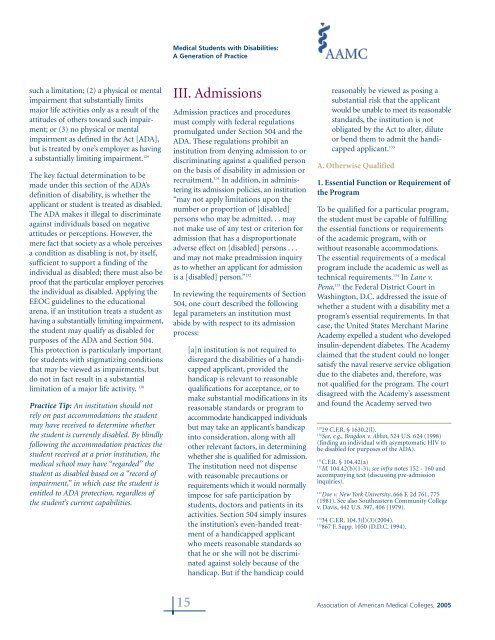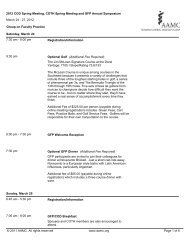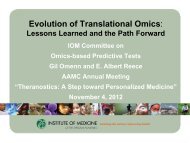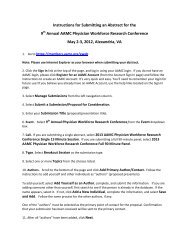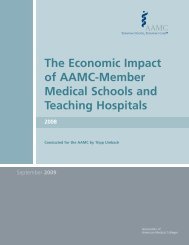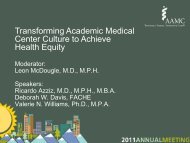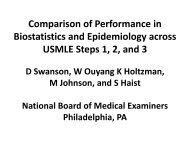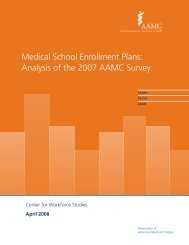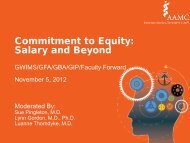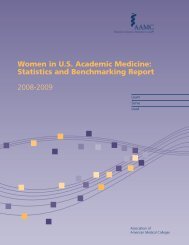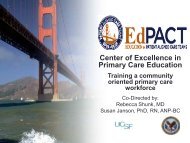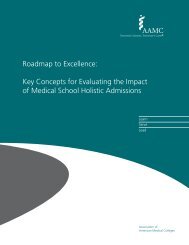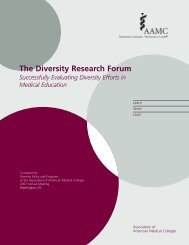Medical Students with Disabilities: A Generation of Practice
Medical Students with Disabilities: A Generation of Practice
Medical Students with Disabilities: A Generation of Practice
You also want an ePaper? Increase the reach of your titles
YUMPU automatically turns print PDFs into web optimized ePapers that Google loves.
<strong>Medical</strong> <strong>Students</strong> <strong>with</strong> <strong>Disabilities</strong>:<br />
A <strong>Generation</strong> <strong>of</strong> <strong>Practice</strong><br />
such a limitation; (2) a physical or mental<br />
impairment that substantially limits<br />
major life activities only as a result <strong>of</strong> the<br />
attitudes <strong>of</strong> others toward such impairment;<br />
or (3) no physical or mental<br />
impairment as defined in the Act [ADA],<br />
but is treated by one’s employer as having<br />
a substantially limiting impairment. 129<br />
The key factual determination to be<br />
made under this section <strong>of</strong> the ADA’s<br />
definition <strong>of</strong> disability, is whether the<br />
applicant or student is treated as disabled.<br />
The ADA makes it illegal to discriminate<br />
against individuals based on negative<br />
attitudes or perceptions. However, the<br />
mere fact that society as a whole perceives<br />
a condition as disabling is not, by itself,<br />
sufficient to support a finding <strong>of</strong> the<br />
individual as disabled; there must also be<br />
pro<strong>of</strong> that the particular employer perceives<br />
the individual as disabled. Applying the<br />
EEOC guidelines to the educational<br />
arena, if an institution treats a student as<br />
having a substantially limiting impairment,<br />
the student may qualify as disabled for<br />
purposes <strong>of</strong> the ADA and Section 504.<br />
This protection is particularly important<br />
for students <strong>with</strong> stigmatizing conditions<br />
that may be viewed as impairments, but<br />
do not in fact result in a substantial<br />
limitation <strong>of</strong> a major life activity. 130<br />
<strong>Practice</strong> Tip: An institution should not<br />
rely on past accommodations the student<br />
may have received to determine whether<br />
the student is currently disabled. By blindly<br />
following the accommodation practices the<br />
student received at a prior institution, the<br />
medical school may have “regarded” the<br />
student as disabled based on a “record <strong>of</strong><br />
impairment,” in which case the student is<br />
entitled to ADA protection, regardless <strong>of</strong><br />
the student’s current capabilities.<br />
III. Admissions<br />
Admission practices and procedures<br />
must comply <strong>with</strong> federal regulations<br />
promulgated under Section 504 and the<br />
ADA. These regulations prohibit an<br />
institution from denying admission to or<br />
discriminating against a qualified person<br />
on the basis <strong>of</strong> disability in admission or<br />
recruitment. 131 In addition, in administering<br />
its admission policies, an institution<br />
“may not apply limitations upon the<br />
number or proportion <strong>of</strong> [disabled]<br />
persons who may be admitted. . . may<br />
not make use <strong>of</strong> any test or criterion for<br />
admission that has a disproportionate<br />
adverse effect on [disabled] persons . . .<br />
and may not make preadmission inquiry<br />
as to whether an applicant for admission<br />
is a [disabled] person.” 132<br />
In reviewing the requirements <strong>of</strong> Section<br />
504, one court described the following<br />
legal parameters an institution must<br />
abide by <strong>with</strong> respect to its admission<br />
process:<br />
[a]n institution is not required to<br />
disregard the disabilities <strong>of</strong> a handicapped<br />
applicant, provided the<br />
handicap is relevant to reasonable<br />
qualifications for acceptance, or to<br />
make substantial modifications in its<br />
reasonable standards or program to<br />
accommodate handicapped individuals<br />
but may take an applicant’s handicap<br />
into consideration, along <strong>with</strong> all<br />
other relevant factors, in determining<br />
whether she is qualified for admission.<br />
The institution need not dispense<br />
<strong>with</strong> reasonable precautions or<br />
requirements which it would normally<br />
impose for safe participation by<br />
students, doctors and patients in its<br />
activities. Section 504 simply insures<br />
the institution’s even-handed treatment<br />
<strong>of</strong> a handicapped applicant<br />
who meets reasonable standards so<br />
that he or she will not be discriminated<br />
against solely because <strong>of</strong> the<br />
handicap. But if the handicap could<br />
reasonably be viewed as posing a<br />
substantial risk that the applicant<br />
would be unable to meet its reasonable<br />
standards, the institution is not<br />
obligated by the Act to alter, dilute<br />
or bend them to admit the handicapped<br />
applicant. 133<br />
A. Otherwise Qualified<br />
1. Essential Function or Requirement <strong>of</strong><br />
the Program<br />
To be qualified for a particular program,<br />
the student must be capable <strong>of</strong> fulfilling<br />
the essential functions or requirements<br />
<strong>of</strong> the academic program, <strong>with</strong> or<br />
<strong>with</strong>out reasonable accommodations.<br />
The essential requirements <strong>of</strong> a medical<br />
program include the academic as well as<br />
technical requirements. 134 In Lane v.<br />
Pena, 135 the Federal District Court in<br />
Washington, D.C. addressed the issue <strong>of</strong><br />
whether a student <strong>with</strong> a disability met a<br />
program’s essential requirements. In that<br />
case, the United States Merchant Marine<br />
Academy expelled a student who developed<br />
insulin-dependent diabetes. The Academy<br />
claimed that the student could no longer<br />
satisfy the naval reserve service obligation<br />
due to the diabetes and, therefore, was<br />
not qualified for the program. The court<br />
disagreed <strong>with</strong> the Academy’s assessment<br />
and found the Academy served two<br />
129<br />
29 C.F.R. § 1630.2(l).<br />
130<br />
See, e.g., Bragdon v. Abbot, 524 U.S. 624 (1998)<br />
(finding an individual <strong>with</strong> asymptomatic HIV to<br />
be disabled for purposes <strong>of</strong> the ADA).<br />
131<br />
C.F.R. § 104.42(a)<br />
132<br />
Id. 104.42(b)(1-3); see infra notes 152 - 160 and<br />
accompanying text (discussing pre-admission<br />
inquiries).<br />
133<br />
Doe v. New York University, 666 F. 2d 761, 775<br />
(1981). See also Southeastern Community College<br />
v. Davis, 442 U.S. 397, 406 (1979).<br />
134<br />
34 C.F.R. 104.3(l)(3)(2004).<br />
135<br />
867 F. Supp. 1050 (D.D.C. 1994).<br />
15 Association <strong>of</strong> American <strong>Medical</strong> Colleges, 2005


